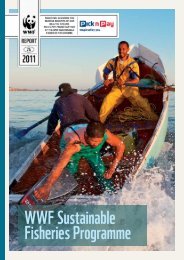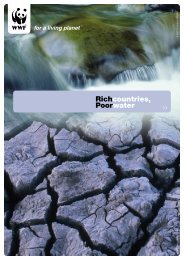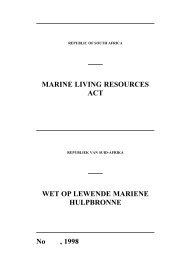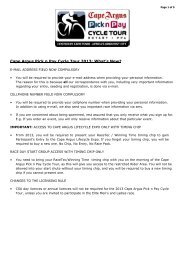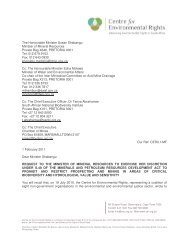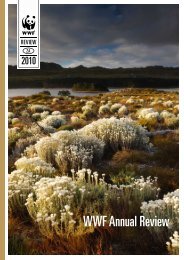State of Management of South Africaââ¬â¢s ... - WWF South Africa
State of Management of South Africaââ¬â¢s ... - WWF South Africa
State of Management of South Africaââ¬â¢s ... - WWF South Africa
- No tags were found...
Create successful ePaper yourself
Turn your PDF publications into a flip-book with our unique Google optimized e-Paper software.
STATE OF MANAGEMENT OF SOUTH AFRICA’S MARINE PROTECTED AREASisland MPAs, and the recreational catching <strong>of</strong> West Coast rock lobster in the Sixteen MileBeach MPA.Managers suggested that there needed to be regulations or policies for non-consumptiveuses, such as sailing and kitesurfing which are expected to disturb birdlife, and for fishingcharters and competitions in MPAs. Furthermore they alleged that the lack <strong>of</strong> definition forthe term “adverse impact” in the MLRA could lead to variable interpretations, and in somecases be applied too broadly. It was suggested that dual designation <strong>of</strong> the adjacent MPAs,under both the MLRA and the NEM:PAA, would assist management and allow for bettercontrol over non-consumptive activities.<strong>Management</strong> indicated that there had been problems in implementing and effectivelycontrolling the ORV regulations due to capacity issues and possible misinterpretation <strong>of</strong> thelegislation. Furthermore it was reported that the slipways were not yet registered.5.2.3 MPA designMPA DESIGN (58%)The WCNP MPAs comprise <strong>of</strong> a lagoon, three islands and a long sandy beach, whichcreates a complex site for management. There were some areas that were critical for themaintenance <strong>of</strong> the ecological integrity <strong>of</strong> the MPA that had not been fully incorporated in theMPA. These included a fish nursery area in the harbour and an area with rock lobster andabalone around the military peninsula. No expansion to these areas was possible.The lagoon had been divided in to three visitor-use zones: Zone A: Multi-use Zone: This area is managed as a marine Controlled Zone withenforcement <strong>of</strong> the MLRA. Fishing and motorized vessels are allowed. Zone B: Restricted Zone: Fishing and the use <strong>of</strong> any motorized vessel can only takeplace on authority <strong>of</strong> and in accordance with a permit obtained from the managementauthority. Fishers with net fishing rights are permitted to fish. Zone C: Sanctuary Zone: no boats or extractive uses are permitted.There had been difficulties controlling sail boats moving into the sanctuary zone due to theopen nature <strong>of</strong> the system. Conflicts had arisen between kite surfers and swimmers, andbetween kite surfers and fishermen. This had been improved to a limited extent through thedesignation <strong>of</strong> kite board launch areas (refer to figure 5.1).Pg 49






